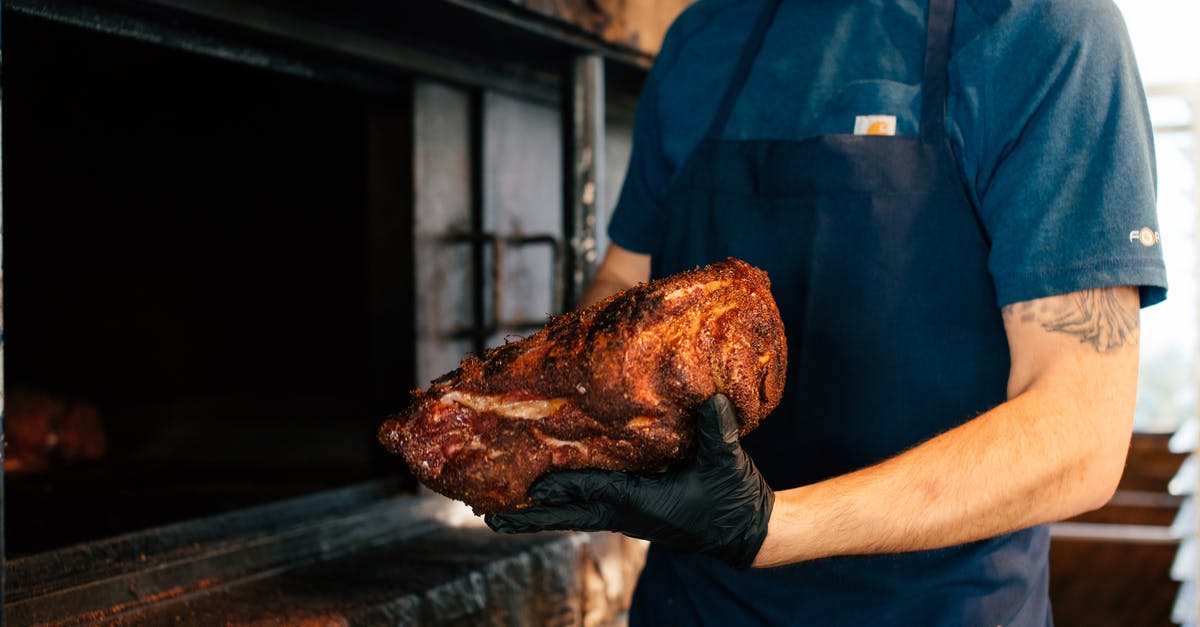Why tie a non-stuffed beef pot roast?

Recipes for beef pot roasts often include the step of tying the roast with twine prior to cooking, even for roasts without stuffing. Why? What difference in outcome can I expect between a tied roast and an untied roast, all other things equal?
Best Answer
@aaronut is right that trussing will maintain the more cylindrical shape you want. However, I feel like he's a little misleading about surface area.
A cylindrical roast actually has LESS surface area relative to the mass of the roast than a flat one. A plate will have more surface area than a ceramic cylinder of the same mass. As a consequence, the cylindrical roast means that less of the meat's mass is exposed directly to heat than for a flat one.
A flat roast will cook faster in the same heat because the middle of the roast (where you're trying to hit a target temp) is closer to the outside (where the heat is). At what would be considered standard roasting temps, this means that your middle will be up to temperature before much nice crusty stuff is formed. The whole roast will be more uniform in temperature.
With a cylindrical roast, on the other hand, the outside will be cooked much longer (and get crustier) before the relatively well-protected center is up to the heat you want. The roast will also have greater thermal mass, which means it will hold heat longer after coming out of the oven.
So is this good? It depends. Most people really like the great flavor that's imparted when the meat gets a nice, browned crust. To get that, you either need a lot of heat, or long exposure to heat.
If you are working with high heat, you're better off with a flatter roast so the outside isn't burned before the middle is ready. This works well with leaner cuts that would get tough or dry if cooked a long time, or where you want relatively more crust than middle. Steaks are nice with a lot of crust, for example.
If you are working with lower heat (which is much more forgiving, as the slower cooking means you don't have to be quite so exact getting the meat out of the heat), you want the more cylindrical roast. The low heat is going to take a while to get a crust on the outside, and the cylindrical shape extends the overall roasting time, giving plenty of time for the crust to form. This method works nicely for meats that benefit from longer slower cooking, and where you want the proportion of crust to middle to be low. A roast, where the nice pink inner part is the real draw, is ideal in this situation.
Pictures about "Why tie a non-stuffed beef pot roast?"



Quick Answer about "Why tie a non-stuffed beef pot roast?"
Trussing a roast is an important step because it gives the meat a uniform shape, helping it cook more evenly. If you've never trussed meat before, this is a great place to start. A roast is the easiest cut of meat to tie. Truss the roast by cutting 12 inches or so of kitchen twine.Do I need to truss a roast?
Trussing beef before roasting helps retain its shape while it cooks in the oven and stops the meat from spreading. This method can also be used for stuffed and rolled joints of meat to hold them together. The trussing method works by tying a series of interlinked knots to secure the meat in place.Do you leave the rope on a roast?
If you are just making a pot roast that will fall apart anyway you can take it off, but if you are hoping to "carve" the roast in front of guests you want to cook it in the bag.What is the reason for tying roasts into a more even shape?
Tying a roast forces it into a more even shape, ensuring that the thin, narrow ends won't overcook before the thick middle part is done. Tying also makes for a nicer presentation and easier slicing.Dutch Oven Pot Roast Beef with Carrots and Potatoes
More answers regarding why tie a non-stuffed beef pot roast?
Answer 2
Since ovens cook by heat radiation, you want to expose as high a proportion of the surface area as possible, which is why most roasts are vaguely cubic or cylindrical in shape. Any part of the meat that's pressed against the pan (i.e. the bottom of the roast) isn't going to get that nice brown crust.
It's also very important with slow-cooking methods that require you to put some liquid at the bottom of the vessel; obviously you want as little of the meat as possible to be in the water, so that most of the work is done by steam.
Tying (or more accurately, trussing) the meat is simply how you maintain the shape in the oven. If you don't truss it, then you'll not only end up with a very flat roast, you'll also end up with uneven cooking, and only the top will be browned since there are no "sides" to speak of.
It's similar with chicken and other birds; you truss the legs so that the oven has a chance to crisp them up on all sides, not just the top.
Answer 3
If you dont truss up it up into a nice round shape the thinner parts will be overdone by the time the thicker part is done.
Sources: Stack Exchange - This article follows the attribution requirements of Stack Exchange and is licensed under CC BY-SA 3.0.
Images: ArtHouse Studio, Pixabay, Horizon Content, Rachel Claire
